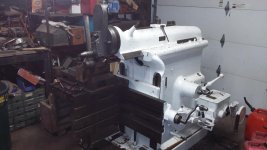pnowakmetallurgist
Aluminum
- Joined
- Jul 22, 2006
- Location
- beloit, wi
I have purchased a 24" G&E shaper last fall and recently got it running. It was working just fine but the table cross feed has started to bind. I'm not sure how to fix this. I've located two gibs, one under the top edge of the table and one about mid-way down. These are held in place with set screws but I don't see any way to adjust the position of the gib. Any recommendations for that? This machine is nearly identical to the one the Mike Wiggins on Backyard Machinist has. I have not been able to locate a serial number or literature for this specific model. I did check the Vintage Machinery site and they do have some but not for this unit. Does anyone have anything more applicable?
Thanks
Thanks














